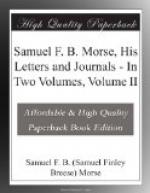MY DEAR SIR,—I will not apologize for having so long delayed answering your kind letter, being, as you well know, privileged by my friends to be a lazy correspondent. I was sorry to find that you should have suffered the recollection of any hasty expressions you might have uttered to give you uneasiness. Be assured that they never were remembered by me a moment after, nor did they ever in the slightest degree diminish my regard or weaken my confidence in the sincerity of your friendship or the goodness of your heart. Besides, the consciousness of warmth in my own temper would have made me inexcusable had I suffered myself to dwell on an inadvertent word from another. I therefore beg you will no longer suffer any such unpleasant reflections to disturb your mind, but that you will rest assured of my unaltered and sincere esteem.
Your letter and one I had about the same time from my sister Mary brought the first intelligence of the sale of my picture, it being near three weeks later when I received the account from Philadelphia. When you recollect that I considered the “Dead Man” (from the untoward fate he had hitherto experienced) almost literally as a caput mortuum, you may easily believe that I was most agreeably surprised to hear of the sale. But, pleased as I was on account of the very seasonable pecuniary supply it would soon afford me, I must say that I was still more gratified at the encouragement it seemed to hold out for my return to America.
His friend Leslie, in a letter from London of May 7, 1816, writes: “Mr. West said your picture would have been more likely than any of them to obtain the prize had you remained.”
In another letter from Leslie of September 6, 1816, occurs this amusing passage:—
“The Catalogue Raisonne appeared according to promise, but is not near so good as the one last year. At the conclusion the author says that Mr. Payne Knight told the directors it was the custom of the Greek nobility to strip and exhibit themselves naked to the artists in various attitudes, that they might have an opportunity of studying fine form. Accordingly those public-spirited men, the directors, have determined to adopt the plan, and are all practising like mad to prepare themselves for the ensuing exhibition, when they are to be placed on pedestals.
“It is supposed that Sir G. Beaumont, Mr. Long, Mr. Knight, etc., will occupy the principal lights. The Marquis of Stafford, unfortunately, could not recollect the attitude of any one antique figure, but was found practising having the head of the Dying Gladiator, the body of the Hercules, one leg of the Apollo, and the other of the Dancing Faun, turned the wrong way. Lord Mulgrave, having a small head, thought of representing the Torso, but he did not know what to do with his legs, and was afraid that, as Master of the Ordnance, he could not dispense with his arms.”
In the beginning of August, 1816, the young man started out on his quest for money. This was frankly the object of his journey, but it was characteristic of his buoyant and yet conscientious nature that, having once made up his mind to give up, for the present, all thoughts of pursuing the higher branches of his art, he took up with zest the painting of portraits.




